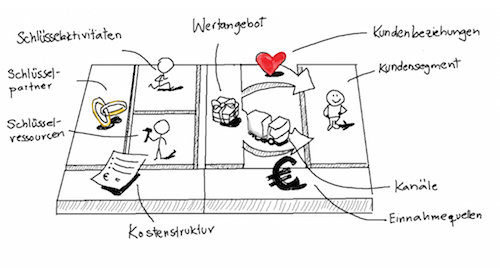Why a detailed analysis of the business model is essential
Business model innovations will become increasingly important in the future. The starting point should be a well-founded analysis of the existing business model. However, this is often perceived as unnecessary - after all, you know your own business. This article explains why it makes sense to examine the existing business model from a superordinate helicopter perspective.

Analysis as a foundation for business model innovation
The basis of every successful business model innovation is the analysis of the existing business model. It makes little sense to work on and further develop a business model without carrying out an appropriate analysis of the actual situation beforehand. This would amount to medication by the doctor without examination and diagnosis. If you want to change the existing business model, you have to consider the entire business model and understand its basic logic.
An innovative product, a new type of technology, a different cost structure or a new sales model do not yet constitute a new business model. Similarly, an innovative earnings model does not yet represent a business model innovation.
Helicopter perspective provides a view of the whole picture
Helicopter perspective means looking at the business model of the entire company from a superior perspective. The individual areas are not analysed down to the last detail, as is the case in a financial report or a production effectiveness report. Instead, all areas of the business model are presented in a clear and easy-to-understand manner using a suitable method. Thus the view of the whole thing is sharpened and one does not lose oneself too much in the detail.
One of the most popular methods for practical implementation is the Business Model Canvas (BMC). It allows the compact visualization of the nine basic areas of a company on just one page. Only through this integrative approach
- All areas of the company can be identified at a glance,
- The boundaries between the individual silos in a company dissolve,
- A comprehensive understanding of the main drivers of entrepreneurial activity is created,
- The interrelationships, cause-effect relationships and weak points of the company's own business model become clear and understandable.

Grafik: seo-trainee.de
Observation on different flight altitudes possible
The analysis of the company's own business model can be based on different flight altitudes, depending on the requirements - from a superficial view from high altitude to a more detailed analysis based on figures at a lower flight altitude.
For example, the BMC can be filled in a few hours by a single person or worked out by several employees in a workshop. If more detailed information is needed, a research project can be carried out over a period of one week, in which each area is underpinned by concrete figures. For example:
- How much revenue is generated by the individual customer segments?
- How much revenue do the different channels generate?
- What are the costs of each channel?
- Which channels are the most profitable?
- What is the cost structure?
- How much does each key resource cost?
- Which key activities cause the highest costs?
- How much does each source of income contribute to total revenue?
- Etc.
The analysis of the business model can therefore take place at different levels of detail. While in some cases a workshop is already sufficient, in other cases more in-depth research will be required to identify new business models.
Concentration on essentials
Looking at it from a helicopter perspective, one always has an eye on what actually constitutes the business model. For example, when working with the BMC, we focus on the essentials at every level of detail in order to understand the core, the real mechanism of the business model.
It shows which activities are not so important or even stand in the way of the goal. The critical aspects can be easily distinguished from minor or quickly solvable problems.
Instead of working on all areas, it is therefore usually sufficient to focus on those areas that have been identified as crucial for success in the particular case. Thus, one remains focused on relevant, essential factors and does not run the risk of getting caught up in detailed or implementation questions in group discussions.
Conclusion: Why a detailed analysis of the business model is essential
If you want to develop a new business model, it is worth taking a look at the existing business model from a superior perspective. With methods such as the Business Model Canvas, business models can be clearly presented and further developed. At a glance, you can see where there are hidden potentials for improvement or weaknesses. At the same time, a common point of reference and a common language will be created, which enables a playful development of ideas and avoids protracted conversations and discussions.









